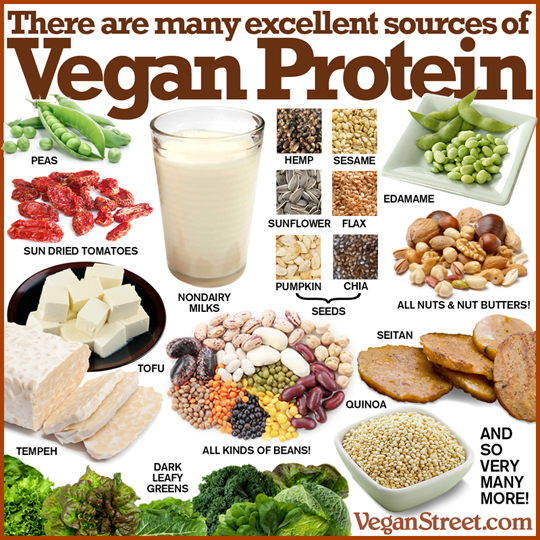Protein panic portends to prevail amongst the vast majority of the population. During this persistent quest for “enough” of this magical macronutrient, priorities shift away from seeking wholesome foods and, simultaneously, a phobia of the other two macronutrients – carbohydrates and fats – ensues.
Here are 5 reasons you can stop pursuing protein and start focusing on food:
 1. Protein is not a food group. It is one of three macronutrients essential in our diet. All whole, intact foods contain some ratio of protein, carbs, and fats. If you eat a wide range of whole plant foods, including about three servings (1 to 1.5 cups) of legumes (beans, peas, lentils, soy foods) a day, you can easily meet your protein needs.
1. Protein is not a food group. It is one of three macronutrients essential in our diet. All whole, intact foods contain some ratio of protein, carbs, and fats. If you eat a wide range of whole plant foods, including about three servings (1 to 1.5 cups) of legumes (beans, peas, lentils, soy foods) a day, you can easily meet your protein needs.
2. We only need approximately 10 to 15 percent of our calories to come from protein. The average woman needs about 46 grams per day and the average man, 56 grams per day, according to the Institute of Medicine. This can also be looked at in grams per kilogram bodyweight per day (g/kg/d), which looks like this by age*:
- 1.5 g/kg/day for infants,
- 1.1 g/kg/day for 1-3 y
- 0.95 g/kg/day for 4-13 y
- 0.85 g/kg/day for 14-18 y
- 0.8 g /kg/day for adults >19 y
- 1.1 g/kg/day for pregnant (using pre-pregnancy weight) and lactating women
*To find out how much you need, simply divide your bodyweight in pounds by 2.2 and multiply the result by the recommended number based on your age. For example, an 120 pound 22 year-old adult needs approximately 44 grams of protein per day (or 120/2.2 = 54.5 kg x 0.8 g/kg/d = 44 g).
 3. Just because something is good, doesn’t mean more is better. It is estimated that the average American consumes approximately twice the RDA for protein. High protein intake – especially from animal sources – may accelerate kidney disease progression and may promote chronic diseases such as diabetes and cardiovascular disease.
3. Just because something is good, doesn’t mean more is better. It is estimated that the average American consumes approximately twice the RDA for protein. High protein intake – especially from animal sources – may accelerate kidney disease progression and may promote chronic diseases such as diabetes and cardiovascular disease.
4. You can find plenty of protein in plants…and packaged better than in animal products. Here are just some of the plant-based protein superstars and the amount of protein they contain per cup:
 All beans (10-29 g)
All beans (10-29 g)- All seeds (24-58 g)
- Nuts/nut butters (20-64 g)
- Tofu (11 g/4 oz)
- Tempeh (41 g)
- Seitan (31 g/3 oz)
- Peas (9 g)
- Lentils (18 g)
- Soy milk (7 g)
- Spinach (5 g)
- Broccoli (4 g)
- Pasta (8 g)
- Brown rice (5 g)
- Quinoa (9 g)
- Veggie burger (13 g)
 5. Athletes may need additional protein, but that is accomplished by increasing overall caloric intake, which is easily done due to the increased appetite that naturally comes along with added energy expenditure. The American College of Sports Medicine recommends
5. Athletes may need additional protein, but that is accomplished by increasing overall caloric intake, which is easily done due to the increased appetite that naturally comes along with added energy expenditure. The American College of Sports Medicine recommends
that “dietary protein intake necessary to
support metabolic adaptation, repair,
remodeling, and for protein turnover
generally ranges from 1.2 to 2.0 g/kg/
day.” But we know there are plenty of vegan athletes who prove protein needs can be proffered by plants. For inspiration, here is my interview of Derek Tresize on What Would Julieanna Do? and you can visit VeganBodyBuilding.com, Vegan Muscle and Fitness, and this recent article by Huffington Post.
So, fret not. Eat plenty of legumes and ample calories to meet your needs and you can stop pursuing protein and start focusing on finding and enjoying wholesome, nutrient-dense, health-promoting plant foods…





This Post Has One Comment
Pingback: But Where Do You Get Your Protein? - Respectful Living